Stenostelma umbelliferum
Stenostelma umbelluliferum (Schltr.) S.P. Bester & Nicholas
Family: Apocynaceae
Common names:
Introduction
Stenostelma umbelluliferum was recently moved to the genus Stenostelma. Previously known as Schizoglossum umbelluliferum, it was rediscovered in 2003 after an apparent absence of 109 years. It has been the topic of much debate and frustration amongst both developers and conservationists due to the uncertainty of its Red List status.
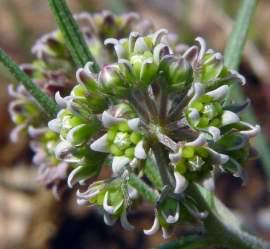
Description
Description
Stenostelma umbelluliferum is a small perennial plant, usually not higher than 120 mm, with a carrot-shaped tuber.
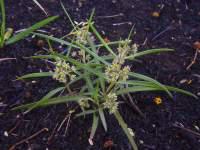

The leaves are opposite, lanceolate (lance-shaped, tapering to the point), hairy and revolute (rolled inwards) on the margins.
The inflorescences are on the axillary or terminal nodes. The flowers are cup-shaped and the edge of the corolla is revolute with a recurved tip. Flowers vary from greenish to cream-coloured on the outside and pink on the inside. The simple corona is lime-coloured.
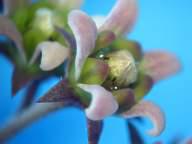
The usually solitary fruit is a follicle and is carried upright in an umbel with longitudinal bands of different shades of green. The seeds are flat and brown and have a white tuft of hairs (coma).
The species is opportunistic and plants flower from September to March, peaking in October to January. After good rains, plants have been found to flower as late as April and have also been found with fruit as early as mid-September indicating that flowering may occur earlier than has been observed.
This species has been overlooked in one of the most abundantly collected grids in the country because of its inconspicuous nature and because it occurs with similar looking taxa that include sprouting grasses, a germinating Ipomoea and Polygala species, all of which resemble Stenostelma umbelluliferum in the sterile state.
Conservation Status
Status
Stenostelma umbelluliferum has undergone a number of changes in Red List status in the past three years and is currently listed as Near-threatened (NT) because of the extent and number of populations.
In Guateng, residential and industrial development has led to the establishment of highly fragmented populations that may not be viable while in the North West, the removal of topsoil associated with open-cast mining has led to habitat destruction. Agriculture is also a threat because the highly fertile soils in which this species occurs are utilized for crops.

The Red List status of the species therefore may need to be changed because of its continued decline throughout its distribution range.
Distribution and habitat
Distribution description
In South Africa, the species is endemic to Gauteng, the North-West, Free State and KwaZulu-Natal.
The habitat is limited to deep black turf, mainly near drainage lines on vertic soils with high clay content in grassland or savanna and at altitudes between 1050 and 1280 m. Plants grow in full sun or light shade. The species is perennial and dies back to a dormant state as an underground tuber after fruiting. The plants seem to thrive in disturbed areas, possibly because disturbed habitats favour the establishment of seedlings and, in the absence of competition, the spread of the species. Large plants are scarce. Population size varies from a few individuals to large populations of more than 100 plants.
Derivation of name and historical aspects
History
Stenostelma umbelluliferum was first collected in 1893 by Rudloph Schlechter while on a collecting trip in South Africa. He found a single plant of this species on the plains at the foot of the Magaliesberg. With the bombing of the Berlin Herbarium during World War II, the type (and at that time the only specimen) was probably destroyed and the species remained obscure.
Rudolph Shlechter is the author of the genus name Stenostelma and although he did not specifically state the origin of the name, it is probably derived from the two Greek words stenos, meaning narrow or slender, and stelma, meaning crown. This refers to the shape of the corona which has a long, drawn-out process or horn in the type species of the genus, S. capense.
The specific name umbelluliferum is assumed to allude to the way the flowers are carried in the inflorescence, typically forming a globose or subglobose umbel.
There are currently four species in this genus. Stenostelma umbelluliferum is easily distinguished from the other species by its size: it is the smallest plant (38-200 mm) with the smallest flowers and the corona does not have any horns, teeth or extensions. The other species are S. capense, S. corniculatum and S. carinatum. The first two are widely distributed and the latter, very restricted, with a few large populations in the Kokstad area.
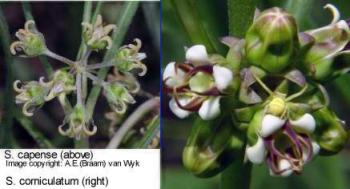
Ecology
Ecology
The depth of the tuber below the soil surface varies greatly, ranging from directly below the surface to about a depth of 20 cm. In the dry season the turf dries out and cracks of up to 0.5 m have been observed. The shape of the tuber is specifically adapted to the drying of the soil and prevents the tuber from being severed when the soil dries out. At the time of the year when this happens, the plants also die back and become dormant till springtime.
Pollinators of the group Miridae have been seen on the plants.
The seeds are distributed by wind and the coma makes it possible for them to be carried by air currents. The establishment of young plants seems to be relatively successful.
Uses
Use
Discussions with farm workers throughout the distribution range revealed that the plant is generally unknown and those who did recognize it from photographs or live plants do not know of any traditional use of the plant.
Growing Stenostelma umbelliferum
Grow
Because of its specific habitat requirements, milky latex and small size, Stenostelma umbelluliferum does not seem to have horticultural potential and would probably only interest those with a passion for this group.
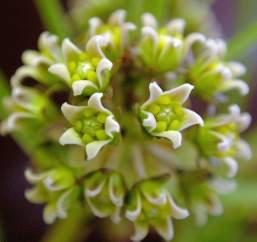
Out of a total of thirty plants that were removed from development sites, six survived in pots for three years. Of these, only two flowered and they did not produce fruit (probably due to the absence of the specific pollinator and because they are outside their natural environment). Fresh seeds obtained from plants from the natural environment germinated well but the survival rate was almost zero. Young seedlings grow very quickly and form a long primary root before growth of the above-ground stems and leaves take place. Very few large plants have been found and most plants seem to be relatively young. Seed set is very good.
Various parasitic infestations by insects have been observed, in many cases causing the plant to wilt and terminate above-ground growth. These include oleander aphids, the milkweed bug and net-winged beetles.
Almost no information about the biology of the plant is known and this may present an opportunity for further study.
References
- Bester, S.P. & Nicholas, A. 2007. Transfer of Schizoglossum umbelluliferum to Stenostelma, and its neotypification (Apocynaceae-Asclepiadoideae). Bothalia 37: 48-51.
- Bester, S.P., Nicholas, A. & Condy, G. 2007. Stenostelma umbelluliferum. Flowering Plants of Africa 60: 96-103.
- Bester, S.P. & Victor, J.E.. 2005. Elusive Schizoglossum rediscovered in Pretoria after 109 years. The Conservation leaflet 3, September 2005: 8. South African National Biodiversity Institute, Pretoria.
- Bester, S.P. & Victor, J.E.. 2005. Schizoglossum umbelluliferum : an unusual milkweed re-collected in Pretoria after 109 years. Veld & Flora Vol. 91 No.4 December 2005 : 166.
Credits
S.P. Bester
National Herbarium, Pretoria
March 2008
Plant Attributes:
Plant Type: Perennial
SA Distribution: Gauteng, KwaZulu-Natal, North West
Soil type: Clay
Flowering season: Spring, Early Summer, Late Summer
PH:
Flower colour: Green, White, Pink, Cream
Aspect: Full Sun
Gardening skill: Challenging
Special Features:
Horticultural zones










Rate this article
Article well written and informative
Rate this plant
Is this an interesting plant?
Login to add your Comment
Back to topNot registered yet? Click here to register.